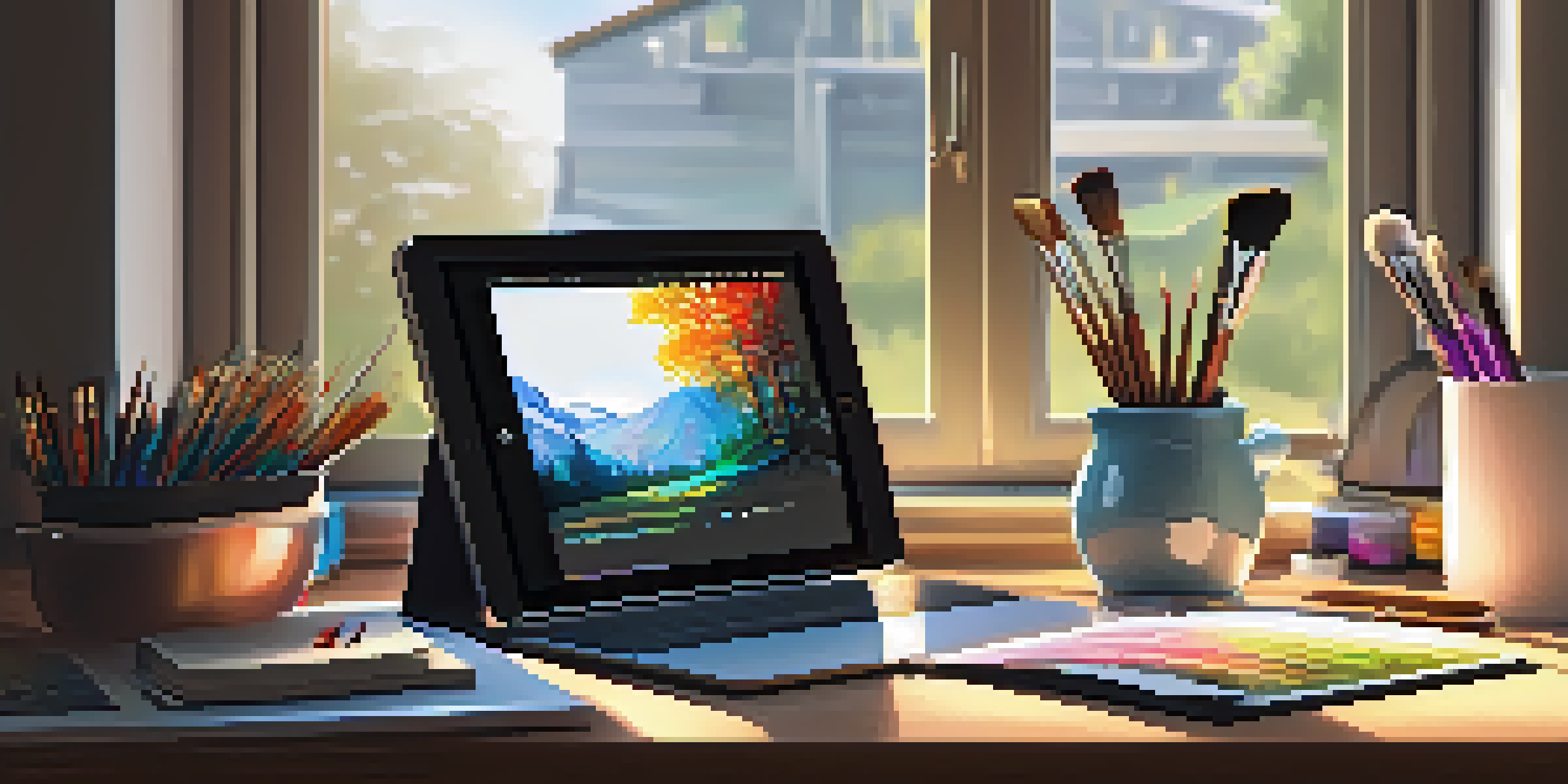NFTs and Moral Rights: Protecting Artist Integrity

Understanding NFTs: A New Frontier for Artists
Non-fungible tokens, or NFTs, are revolutionizing the way artists sell and own digital art. Unlike regular cryptocurrencies, NFTs represent unique items on the blockchain, ensuring that each piece is one-of-a-kind. This uniqueness opens up new avenues for artists to monetize their work, allowing for direct sales without intermediaries. However, as exciting as this technology is, it raises important questions about the protection of artists' rights.
Art is not freedom from discipline, but disciplined freedom.
With the digital landscape expanding, artists now have more opportunities than ever to showcase their work. But, the rise of NFTs also means the potential for misuse or misrepresentation of their creations. This is where moral rights come into play, safeguarding the personal and reputational interests of artists. Understanding both NFTs and moral rights is crucial for artists navigating this new terrain.
As we delve deeper into this topic, it's essential to consider how NFTs can both empower and challenge artists. While they offer new revenue streams, they also necessitate a conversation around ethical practices in the digital art space. By exploring this balance, we can better appreciate the evolving relationship between technology and artistry.
What Are Moral Rights and Why Do They Matter?
Moral rights are a set of protections that ensure artists can control how their work is used and represented. They include the right to attribution, meaning an artist deserves to be recognized for their work, and the right to integrity, which protects against alterations that could harm the artist’s reputation. Understanding these rights is vital for artists entering the NFT market, as they must consider how to maintain their integrity in a rapidly changing landscape.

While copyright laws often focus on economic rights, moral rights emphasize the artist's emotional connection to their work. This distinction is particularly relevant in the realm of NFTs, where digital art can be easily altered or recontextualized. By safeguarding moral rights, artists can ensure that their intention and identity remain intact, even as their work circulates online.
NFTs Transform Artist Monetization
NFTs provide artists with unique opportunities to sell digital art directly, bypassing traditional intermediaries.
The importance of moral rights cannot be overstated, as they serve to protect the artist’s legacy. For example, if an artist’s work is associated with a cause or message they do not support, it can damage their reputation. Thus, understanding moral rights helps artists navigate the complexities of the digital art world while preserving their personal and cultural narratives.
The Intersection of NFTs and Moral Rights
As NFTs gain popularity, the intersection of these tokens with moral rights becomes increasingly significant. Artists now have the ability to tokenize their work, but this does not automatically grant them protection under moral rights laws. Each jurisdiction has different interpretations of these rights, making it crucial for artists to understand their legal standing when entering the NFT market.
Every artist was first an amateur.
For instance, in some countries, moral rights are inalienable, meaning they cannot be sold or transferred. This ensures that even if an artist sells an NFT, they retain certain rights over how their work is used. However, in other jurisdictions, these rights may be less robust, leaving artists vulnerable to exploitation. Understanding these nuances can empower artists to protect their integrity as they engage with this new digital medium.
Navigating this landscape requires a proactive approach. Artists should seek legal advice and educate themselves about the implications of their NFT sales on their moral rights. By doing so, they can better position themselves to protect their creative vision and personal brand in the evolving world of digital art.
Case Studies: Artists Protecting Their Moral Rights
Looking at real-world examples can shed light on how artists are effectively protecting their moral rights in the NFT space. Take the case of a well-known digital artist who sold an NFT of their work but later found it altered without their consent. This situation highlights the risks artists face when their work is not adequately protected, leading to potential damage to their reputation.
In contrast, another artist utilized smart contracts to embed moral rights directly into their NFT. This innovative approach ensures that any future use of their work is subject to their approval, maintaining their artistic integrity. By leveraging technology, they are not just selling art but also preserving their vision and intent.
Moral Rights Safeguard Artist Integrity
Understanding and protecting moral rights is essential for artists to maintain their reputation and control over their work in the NFT space.
These case studies illustrate the importance of being vigilant and proactive in protecting moral rights. As artists continue to explore the NFT realm, learning from the experiences of others can provide valuable insights into how best to safeguard their creative legacy.
Best Practices for Artists in the NFT Space
Navigating the NFT landscape can be daunting, but there are best practices that artists can adopt to protect their moral rights. Firstly, artists should always include clear terms of use when selling their NFTs. This ensures that buyers understand the limits of how the work can be used, helping to maintain the artist's integrity.
Additionally, artists should consider utilizing smart contracts that include clauses about moral rights. These contracts can specify how the artwork can be altered or displayed, providing a layer of security and control. This proactive step helps artists assert their rights while still engaging with the innovative aspects of NFTs.
Lastly, building a strong community around their work can also help artists protect their moral rights. Engaging with fans and fellow artists creates a support network that values and respects the artist's vision. By fostering these relationships, artists can enhance their visibility while ensuring that their work is treated with the respect it deserves.
Legal Considerations for Artists and NFTs
When artists dive into the world of NFTs, understanding the legal landscape becomes paramount. Different countries have varying laws regarding moral rights, and navigating these can be complex. Artists should familiarize themselves with local laws and, when necessary, consult legal professionals who specialize in intellectual property and digital rights.
Moreover, as the NFT market evolves, so too does the legal framework surrounding it. Keeping updated on changes in legislation is essential for artists to ensure they are adequately protected. Being proactive in this area can help artists avoid legal pitfalls and safeguard their work more effectively.
Legal Awareness is Crucial for Artists
Artists must navigate varying laws and stay informed about legal implications to effectively protect their rights when engaging with NFTs.
In addition to moral rights, artists should also consider copyright implications when creating and selling NFTs. While NFTs can offer a new way to monetize art, they do not automatically grant copyright protection. Understanding the differences between these rights will empower artists to navigate the complex legal waters of the NFT space.
The Future of NFTs and Artist Integrity
Looking ahead, the future of NFTs holds both promise and challenges for artists striving to maintain their integrity. As technology continues to evolve, so too will the ways in which artists can protect their moral rights. Innovations in blockchain and smart contracts could offer even more robust protections, ensuring that artists retain control over their work.
However, as the NFT market grows, so does the potential for exploitation. Artists must remain vigilant and informed to navigate this new terrain effectively. By advocating for their rights and educating themselves about the legal landscape, artists can better position themselves for success in the digital art world.

Ultimately, the intersection of NFTs and moral rights is an ongoing conversation that requires collaboration among artists, technologists, and legal experts. Together, they can create a more equitable environment that honors the integrity of artists while embracing the opportunities presented by this new digital frontier.